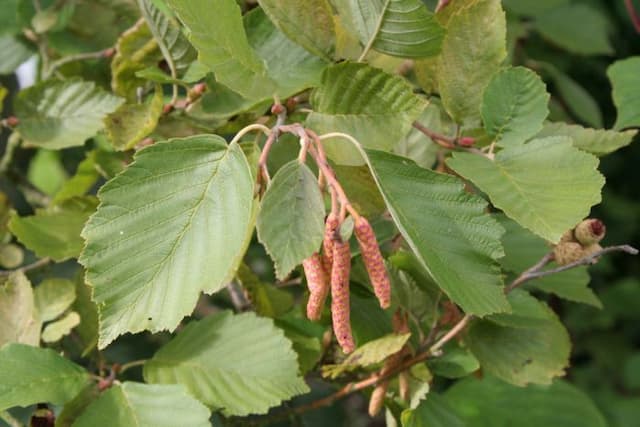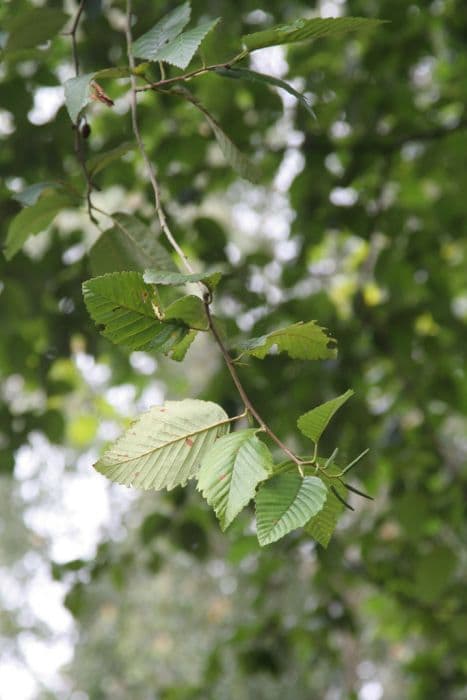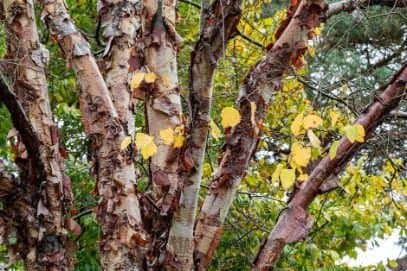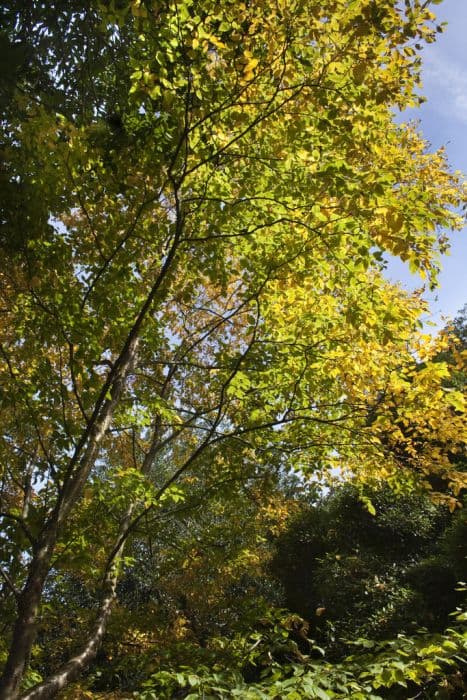Himalayan Birch Betula utilis

ABOUT
The plant commonly known as the Himalayan birch has distinct features setting it apart from other trees. One of its most noted characteristics is the bark. It is creamy-white with a satiny texture and peels off in horizontal sheets, providing a striking contrast to the dark-colored forest backdrop. The bark of this tree can sometimes have a pinkish or coppery hue, making it visually captivating. The leaves of the Himalayan birch are oval to triangular in shape and have a pointed tip with a serrated edge, giving them a slightly jagged appearance. During the growing season, the foliage is a bright green color, turning to a vibrant yellow before falling off in the autumn, providing a seasonal display of color. In terms of flowering, this tree produces long, hanging clusters known as catkins. The male catkins are longer and more prominent, while the female catkins are shorter and more upright. After pollination, the female catkins develop small winged seeds that are dispersed by the wind. Overall, the appearance of the Himalayan birch with its shining white bark and attractive foliage makes it a popular ornamental plant in gardens and parks, while also being valued for its environmental importance in its native habitat.
About this plant
 Names
NamesSynonyms
Himalayan Birch, White Birch, Jacquemontii Birch, Bhojpatra
Common names
Betula bhojpattra, Betula jacquemontii.
 Toxicity
ToxicityTo humans
Betula utilis, commonly known as Himalayan Birch, is not considered toxic to humans. Generally, birch species are not known for containing toxic substances that would cause harm if ingested. Birch trees, including Himalayan Birch, have been used in traditional medicine, and birch sap is sometimes consumed as a beverage. Therefore, there is no notable toxicity or dangerous consequences expected from ingesting parts of this plant for humans.
To pets
Himalayan Birch is also not known to be toxic to pets. Similar to their effect on humans, birch trees do not commonly contain substances that would be considered poisonous to animals. Consuming parts of the Himalayan Birch should not result in toxic effects or notable symptoms of poisoning in pets. However, as with any non-food plant material, ingestion of large amounts could potentially cause mild stomach upset due to the physical irritation or indigestibility of the plant matter.
 Characteristics
CharacteristicsLife cycle
Perennials
Foliage type
Deciduous
Color of leaves
Green
Flower color
Mixed
Height
50 feet (15 meters)
Spread
35 feet (10.7 meters)
Plant type
Tree
Hardiness zones
7
Native area
Himalayas
Benefits
 General Benefits
General Benefits- Ornamental Value: Betula utilis, commonly known as Himalayan birch, is highly valued for its distinctive white bark, making it a popular choice for ornamental purposes in gardens and landscapes.
- Habitat Support: It provides a habitat for various wildlife species, including birds and insects, which find shelter and food in its branches.
- Soil Stabilization: The root system of the Himalayan birch helps stabilize soil and prevent erosion, particularly in hilly or mountainous areas where it is native.
- Climate Resilience: Betula utilis is known for its hardiness and ability to withstand cold temperatures, making it suitable for planting in challenging climates.
- Seasonal Interest: The tree offers seasonal interest with its peeling bark, bright green leaves in spring and summer, and yellow fall color, enriching the visual appeal of the environment throughout the year.
- Timber Production: The wood of Himalayan birch is used in the production of furniture, plywood, and other wood products, contributing to the timber industry.
- Cultural Significance: In some cultures, Betula utilis has cultural and historical importance, featuring in various traditional practices and folklore.
 Medical Properties
Medical Properties- Anti-inflammatory: Betula utilis bark contains compounds that may help to reduce inflammation.
- Antimicrobial: The plant has been traditionally used for its antimicrobial properties, which can help to fight bacterial and fungal infections.
- Antioxidant: The leaves and bark of Betula utilis are believed to have antioxidant effects due to the presence of flavonoids and other phenolic compounds.
- Astringent: The bark is used for its astringent properties, which can help to tighten and tone the skin.
- Diuretic: It has been used in traditional medicine as a diuretic to help promote the production of urine and alleviate water retention.
- Healing: The sap from Betula utilis is traditionally used for its healing properties in skin conditions and wounds.
 Air-purifying Qualities
Air-purifying QualitiesThis plant is not specifically known for air purifying qualities.
 Other Uses
Other Uses- Sunscreen: The sap of the Himalayan birch contains substances that can be used as a natural sunscreen, providing protection against UV rays.
- Roofing Material: The bark of Himalayan birch is durable and waterproof, making it an excellent natural roofing material in some rural areas.
- Canoe Construction: Traditionally, the bark of Himalayan birch was used to make canoes due to its buoyant and water-resistant properties.
- Writing Material: In centuries past, the bark was used as paper, known as 'bhojpatra,' for writing important scriptures and texts in India and Nepal.
- Folk Art Canvas: The smooth surface of the bark serves as a unique canvas for folk artists, particularly in Siberian and Russian cultures.
- Tanning Leather: The tannins in Himalayan birch bark have been used in the leather tanning process.
- Natural Insulation: The bark, being a good insulator, can be used to insulate buildings or packaging sensitive equipment against cold.
- Insect Repellent: The essential oils found in the tree's bark have insect repellent properties and can be used to keep pests at bay.
- Food Smoking: Wood chips from the Himalayan birch are used to impart a distinctive flavor when smoking food items like fish or meats.
- Toy Making: The flexible wood of the Himalayan birch is ideal for crafting intricate toys and models.
Interesting Facts
 Feng Shui
Feng ShuiThe Himalayan birch is not used in Feng Shui practice.
 Zodiac Sign Compitability
Zodiac Sign CompitabilityThe Himalayan birch is not used in astrology practice.
 Plant Symbolism
Plant Symbolism- Purity: The Betula utilis, commonly known as Himalayan Birch, often symbolizes purity thanks to its striking white bark that seems unblemished and clean against the forest backdrop.
- New Beginnings: As a tree that readily proliferates and is one of the first to establish itself in disturbed soil, the Himalayan Birch represents new beginnings and a fresh start.
- Adaptability: Being able to thrive in a variety of conditions, the Himalayan Birch signifies adaptability and the capacity to adjust to different circumstances in life.
- Protection: Historically, birch trees have been seen as protective due mainly to their numerous uses, including their bark which was traditionally used for writing and shelter, suggesting a symbol of protection and shelter.
- Renewal: The Himalayan Birch has the ability to regenerate itself by producing new seeds each year, which has made it a symbol of renewal and continuous growth.
 Water
WaterHimalayan Birch trees prefer consistent moisture for optimal growth, but they do not tolerate waterlogged roots. During the growing season, a good rule of thumb is to water enough to keep the soil moist, which typically means giving the tree about 1-2 gallons of water per week. Adjust this amount during periods of rainfall or drought, ensuring that the water penetrates deeply into the soil. In the winter, you can reduce watering frequency, but do not allow the soil to completely dry out. For young trees, ensure more frequent watering until they establish.
 Light
LightHimalayan Birch trees flourish in areas with full sun to partial shade. The ideal spot would receive at least 6 hours of direct sunlight daily but would also be protected from the intense afternoon sun, if possible. They are resilient and can adapt to a range of light conditions but perform best with adequate sunlight.
 Temperature
TemperatureHimalayan Birch trees can tolerate a wide range of temperatures, from the cold winter lows of -40°F to summer highs of approximately 80°F. They thrive best in cooler climates and may suffer stress in areas where temperatures exceed this range frequently. The ideal temperature conditions for the Himalayan Birch would be between 32°F and 75°F.
 Pruning
PruningPrune the Himalayan Birch during its dormant season in late fall or winter to maintain its shape and remove any dead or diseased branches. This precaution prevents the spread of disease and secures strong growth in the spring. Pruning is also needed to clear away any branches that may interfere with walkways or structures.
 Cleaning
CleaningAs needed
 Soil
SoilHimalayan birch thrives best in well-drained, cool, and moist soil rich in organic matter. The ideal soil pH for Betula utilis should be slightly acidic to neutral, ranging from pH 5.5 to 7.5. Incorporating leaf mold or compost into the soil mix can improve its structure and fertility.
 Repotting
RepottingSince Himalayan birch is a large tree, it is typically not repotted but rather planted and left to grow in the same spot. It may need occasional transplanting early in its life cycle, perhaps once every couple of years as it outgrows its space.
 Humidity & Misting
Humidity & MistingThe Himalayan birch prefers moderate to high humidity levels. Best humidity conditions would mimic its native mountainous regions; however, it is quite adaptable and can tolerate lower humidity environments when planted outdoors in a suitable climate.
 Suitable locations
Suitable locationsIndoor
Ensure bright light, cool air, and moist soil.
Outdoor
Full sun to partial shade, well-drained soil, water regularly.
Hardiness zone
7-9 USDA
 Life cycle
Life cycleBetula utilis, commonly known as Himalayan birch, begins its life cycle as a seed that germinates in suitable moist, cool conditions, often in spring. The seedling emerges and develops into a juvenile plant, establishing itself with a root system and a straight, slender trunk surrounded by white, papery bark. Through the vegetative stage, the plant exhibits significant growth, producing serrated, ovate leaves and gaining height and girth. As it matures into an adult, the Himalayan birch becomes capable of reproduction, forming male and female catkins that facilitate cross-pollination, primarily through wind dispersal. Following successful pollination and fertilization, seeds are produced and dispersed, typically by wind, starting the cycle anew. The mature birch can live for many years, with some individuals reaching well over a century in age, throughout which it continues to produce seeds seasonally.
 Propogation
PropogationPropogation time
Spring to Summer
The Himalayan Birch, or Betula utilis, can be propagated through several methods, but seed sowing is the most popular and frequently utilized. The best time to collect seeds for propagation is late summer or early autumn, as the seeds mature. To propagate by seed, one should sow them as soon as they are ripe into a well-drained, sandy seedbed, covering the seeds lightly. Stratification, a process of exposing the seeds to cold temperatures to break dormancy, is generally not required for Betula utilis, but if germination does not occur in the first spring, a cold period could induce the process in the second year. Once sown, the seedbed should be kept moist until germination, which typically occurs in the spring. Seedlings require protection from extreme conditions and can be transplanted to their permanent locations once they've grown sufficiently to handle the stress of movement.









